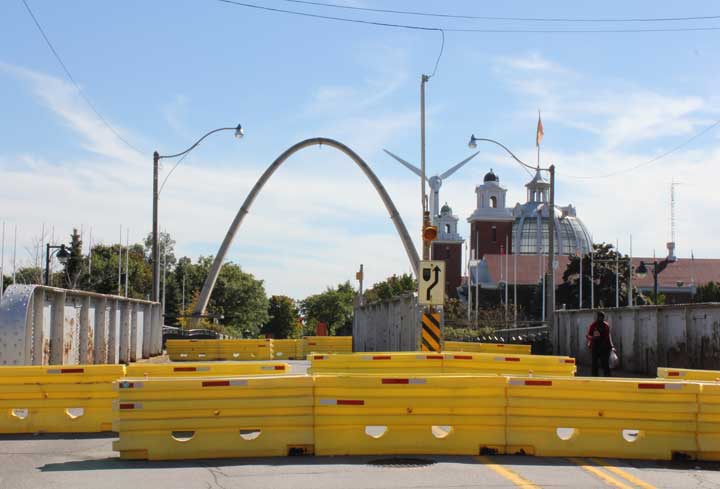The consulting engineer who warned the city that the Dufferin Bridge needed urgent repairs in 2008 says that the bridge shouldn’t have remained open as long as it did.

The city closed the bridge to vehicle traffic in May 2013, although it had received advice years before saying that the bridge needed urgent repairs.
Doug Webb, who is currently a Vice President at the engineering company SEMA , was working with engineering firm UMA/AECOM in 2007 and 2008, when the City of Toronto requested proposals for rehabilitating the two Dufferin Bridges, one above the Gardiner Expressway and one above a busy rail corridor.
Webb examined the bridge and his evaluation wasn’t good.
“Just the whole bridge at Dufferin, its overall condition was very poor. The steel had corroded, the concrete was falling apart. The bridge had just come to the end of its life. It was a hundred years old,” said Webb in an interview.
In his report, he observed that the primary steel members of the bridge were severely corroded and that the concrete deck was in “very poor to bad” condition, with cracked and missing concrete and visible holes all the way through to the asphalt.

“My recommendation was to strengthen the connections and if you wanted to keep it to replace the deck at the very least,” he said. “That’s not a big stretch of work. The City of Toronto does work on all kinds of bridges at all different times. Make this one a priority.”
Michael D’Andrea, Executive Director of Engineering and Construction Services for the City of Toronto told Global News on Monday that some repairs were made, saying, “We wouldn’t have left that bridge deck unattended if there was a deficiency found with that bridge, particularly if there was a hole in the deck.” However, city staff have also confirmed that the hole identified in Webb’s 2008 report was not repaired.
The recommended struts were never added, nor was the deck replaced. While the city eventually restricted the weights of vehicles using the bridge, it a did not follow other recommendations from subsequent engineering reports in 2009, including installing a temporary bridge.
“When you look at the consultant’s report in 2008, at no point did they recommend shutting down the bridge to vehicle traffic,” said D’Andrea.
“Nowhere did I recommend closing the bridge (at that time) because I figured that the city would carry out the recommendations in my report,” wrote Webb in a follow-up email.
D’Andrea said that for the city, “Public safety is paramount.” He points to a November 2012 inspection which found the bridge to be operable. Six months later, city staff and consulting engineers reassessed and recommended its closure to vehicles in June.
When asked about the discrepancy between the 2012 inspection and his 2008 findings, Webb said, “Everybody’s going to have a different opinion, right?”
“Somebody might say oh that guy’s overreacting, the bridge is fine. But when I looked at it, that wasn’t my professional opinion.”
When asked if he thinks the bridge should have remained open another five years, he replied, “No.”
Asked to respond to Webb’s comments, the city said the following: “We hire professional engineering firms such as AECOM to provide reports to us to help us in decision making, which AECOM did, and we are not prepared to enter into a debate with a former employee of one of those firms.”
Construction delayed
The bridge’s troubles go back even earlier. Webb had seen first-hand problems with the bridge a decade before his report, while working for a different engineering firm.
In 1995, his employer was hired to fix the Dufferin Bridge. “At the time they wanted to replace the bridge in about five years’ time,” he told Global News. “At that time the City of Toronto (…) said yeah, get us five more years out of this baby.”
At that time, repairs were performed, but they were only intended to extend the bridge’s life by five years.
Webb isn’t sure why the city didn’t respond to his recommendations in 2008. He left AECOM in 2009, so was no longer part of the project. But he thinks that the number of stakeholders involved may have slowed things down.
“Initially our proposal was for a rehabilitation design. And that proposal was to replace Dufferin Street over the tracks and fix up the one over the Gardiner Expressway,” he said.
But plans soon changed and he was asked to look at ways to extend the bridge’s life by a few years while designs for a new bridge were worked out.
“The problem was is that GO Transit wants to add two more tracks. So now you have a bridge that’s longer. And then CNR, which also uses the corridor, wants more clearance for trains,” he said. “And they said okay, we need a higher bridge. And the TTC said maybe we want to run a streetcar over the bridge. So now you have a wider bridge.”
He thinks that the Dufferin Bridge could have been an interesting design opportunity. “My dream always was, yeah, knock down both these bridges and build a nice cable-stay bridge across the Gardiner. Like a signature bridge.”
“I thought you could really do something wild here, something really unique. You could build the gate into the CNE and a nice cable-stay bridge, over the tracks, over the Gardiner. No piers required and it would look really good. I don’t know whether they ever looked at that plan or not. It would cost a few bucks.”




Comments